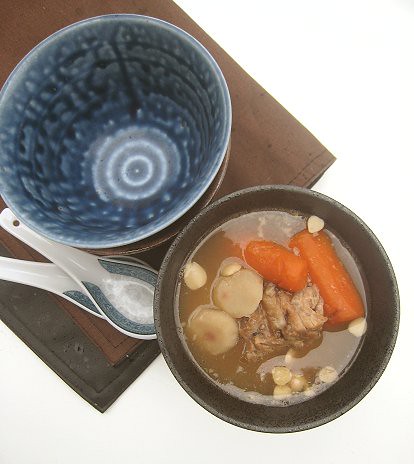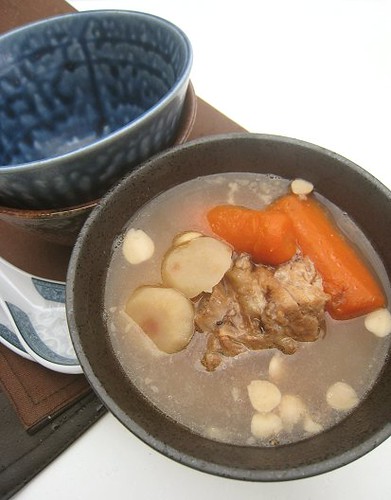
TS:
You may be wondering, "Soup? Isn't it almost summer?"
"Rain, rain, go away. Come again another day."
TS:
Apparently, we missed the memo here, as it's been raining quite a bit lately. I think it's unusual to be raining this much at this time of the year, even for Vancouver! Soup right now is just the thing.
Actually, in Cantonese households especially, soup is an essential part of the meal, regardless of the season. As explained in the Winter Melon Soup post on Appetite for China, the Cantonese thinking is that without soup, one might as well be eating barbarian food. ;)
These Chinese soups also have a lot of supposed "medicinal" advantages, a good way to apply the knowledge gleaned from several millenia of history of traditional Chinese medicine into daily life.
With our advancing age (hehe) and the resulting focus on health, I thought it was high time we made more of these soups.
First: Blanch pork neck pieces in hot water to "clean" them. Discard water.
TS:
"Pork bone" refers to what is usually labelled "pork neck bone". Contrary to its name, there is actually still a substantial amount of meat on them. They're very nice for soups and they're very inexpensive! Usually about a dollar a pound.
For the past twenty years, although pork bones are a staple in our household and we have pork bone soup on average once in two weeks, we have had only one pork bone (ma-kut) soup: Pork Bone and Daikon Radish Soup.
Strangely enough, we don't have a post on this, our standard Ma-Kut Soup! I'm putting that on our list of things to post. Here's a version with watercress and Shanghai bok choy.
For the record, this watercress and Shanghai bokchoy pork bone soup was not open-heartedly welcomed by all when we made it. Our family are loyalists when it comes to pork bone soup: they like what they like.
Me? Not so much. I'm not a big fan of our standard pork bone and radish soup. I always feel left out when Mama (or JS) makes it. That's why I decided to experiment with other pork bone soup combinations.
Second: Peel and cut carrots into large chunks. Drain canned water chestnuts.
TS:
We tried out a couple of pre-packaged soup combinations from our local Asian supermarket a while back (documented here and here).
Besides those two soups, I have no experience with Chinese soups. That's why when I decided to venture out into the great unknown of pork bone soup delights, I decide to keep things pretty neutral and chose non-threatening ingredients.
Carrots and water chestnuts. Very non-threatening.
Third: Measure out your "Chinese" ingredients.
Clockwise from top left: black-eyed peas, honey dates, apricot kernels, and conpoy (dried scallops).
TS:
To learn more about Chinese soups, I turned to The Chinese Soup Lady!
The Chinese Soup Lady is a blog maintained by two sisters and is dedicated to Chinese Soups. (I bet you couldn't figure that out!) They have information on ingredients used to make soups, as well as soup recipes and their intended effects.
For example, according to the Chinese Soup Lady, the ingredients I have for my soup have the following properties:
carrots: rich in dietary fibre, antioxidants, and minerals
water chestnuts: relatively "cooling" food; said to help relieve coughs
black-eyed peas: low in fat and high in protein
honey dates: sweet; assists with constipation (because of their mild laxative effect), anemia, fatigue
apricot kernels: used to help relieve "heatiness"; good for coughs
conpoy (dried scallops): flavorful; beneficial to yin
See! Don't the health benefits make you want to run off and make some Chinese soup now?
Fourth: Dump everything into a pot and simmer for a long, long, looooong time.
TS:
I love this as it's a dump-into-a-pot recipe. Let boil then simmer on low. It takes a long time.
After twelve hours, the broth was super clear, but I still wasn't satisfied with the flavor. Not wanting to wait any longer, I turned the heat up higher. The soup was on a low boil, so after about two hours, I finally had the flavor I was looking for. The downside, the broth turned cloudy.
Although, that isn't such a bad thing. This is the look that some people aim for, particularly in Japanese ramen broths, or Korean oxtail soup.
TS:
There you go. This is a very light yet flavorful soup.
It's pretty good for a beginner. But, tasting other Chinese soups (for example, the pork and lotus root soup at Shanghai Village), I know how much there is to learn about making these Chinese soups. Mine still didn't seem as "sweet" and flavorful.
JS and I were speculating, perhaps we should use chicken broth instead of water to add to the pork. Hmm...
P.S. I love the crunch of the water chestnuts. Still crunchy after 12+ hours of cooking.
To learn all about Chinese Soups, go to:
The Chinese Soup Lady.com
Enjoyed this post? Why not subscribe to our blog? Subscribe via reader or subscribe via email. Thank you! |
eatingclub Hong Kong/Cantonese
Chicken Chow Mein
Cantonese Braised Beef Brisket, Two Ways
Lobster Congee from a Lobster Feast
Chinese Roast Pork Belly
Gailan (Chinese Broccoli) with Oyster Sauce, Two Ways
Chinese Pork Bone Soup with Carrots and Water Chestnuts
Hong Kong-style Curry Cuttlefish
Dimsum Seafood Trio: Black Pearl Prawn Toast, Scallop in Nest, Jewelled Rice Cup
Hong Kong-style Singapore Noodles (星洲炒米)
Hong Kong-style Stir-fried Water Spinach with Shrimp Paste (蝦醬通菜)
Hong Kong-style Stir-fried Rice Noodle with Beef (乾炒牛河)
Sweet and Sour Pork
Hong Kong-style Curry Beef Brisket (咖喱牛腩), 1st Attempt







You don't need to add chicken broth, but maybe a little chicken bouillon to taste. I like to eat the pork bone meat with soy sauce, so that might be enough salt right there.
ReplyDeleteLove the idea of this soup & the use of the cheaper cut of meat
ReplyDeleteNate:
ReplyDeleteWe're going to experiment making a "Supreme" stock and see how that goes, hehe.
kat:
Thanks. =)
Being Chinese myself, I can say that people don't normally add Chicken Broth to everyday soup, especially if you want the health benefit (sodium).
ReplyDeleteYou can try adding figs instead for some extra flavor, and we commonly add tomato to this soup too!
Oh wow, figs?
Delete